Kitchen aprons made of stone: varieties and selection criteria
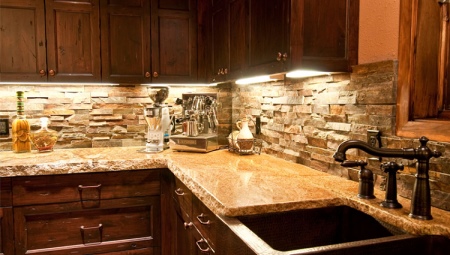
In many design directions, a stone apron is suitable for the kitchen. He seems unshakable, reliable and eternal. But it also has its negative sides, which we will discuss in the article. The advantages of such a material are a wide variety of patterns, colors and textures.
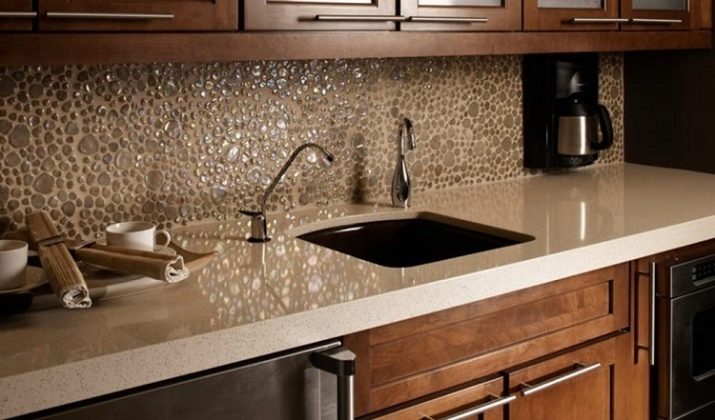
Peculiarities
Aprons for the kitchen can be made of artificial, natural and decorative stone. Marble, granite, malachite, basalt, onyx are often used as a natural material for these purposes. Artificial stone is represented by agglomerate and acrylic. Besides, stone aprons can be made of decorative finishing materials such as plaster, concrete, brick, pebble mosaic.
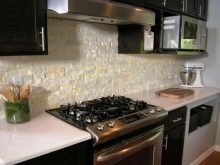
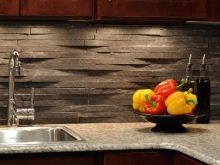
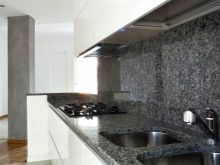
Materials (edit)
Consider all the materials used to create aprons.
A natural stone
Natural material has a wide palette of colors and a wide variety of patterns, it looks incredibly beautiful and expensive, but very capricious to care for. Any stains will have to be removed immediately, without waiting for absorption into the surface. The following types of stone are suitable for an apron.
- Marble. A noble material in delicate shades, it can decorate any kitchen or support many historical styles. The translucent version gives the room a special lightness, airiness. The disadvantages include the high porosity of the material, due to which splashes of grease and dirt are absorbed into the surface.
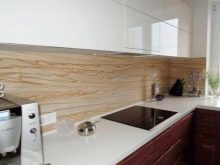
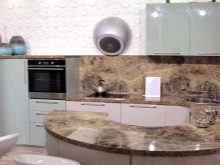
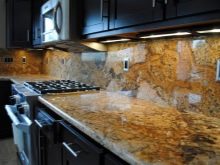
- Onyx. An amazingly beautiful stone of yellowish, greenish, brown color with a unique pronounced pattern. With good lighting, it seems to be illuminated from the inside.
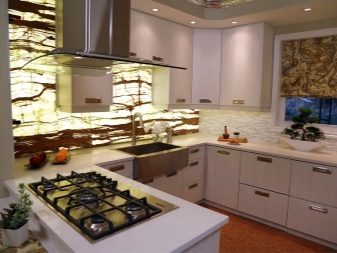

- Granite. Unlike other natural stones, granite is endowed with high density and strength.He is not afraid of spilled coffee and drops of fat, he is not afraid of high temperatures and is easy to clean even with the help of household chemicals. Granite has different shades: white, pink, gray, black, terracotta.
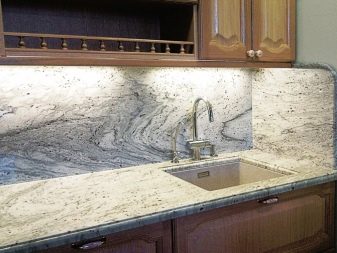

- Travertine... In appearance, this material is something between limestone and marble. It contains beautiful patterns and pleasing shades ranging from white to red. But mainly it can be found in sand versions.
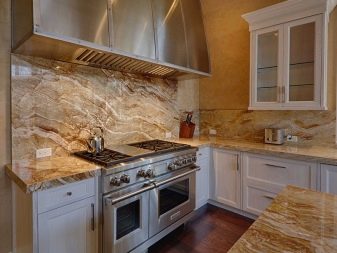
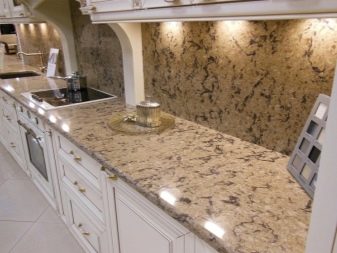
Artificial
It can convey the appearance of a natural stone with a high degree of reliability, but, unlike it, it has a high density and does not absorb dirt, it is easy to care for it. The apron in the kitchen is made of the following artificial materials.
- Acrylic. Made with minerals, acrylic resins and dyes. Thanks to the plastic structure, the apron can be made seamless; moreover, it is possible to make it together with an acrylic tabletop, a single monolithic product. The material is able to repeat the color and pattern of any stone or have a uniform bright surface.
Acrylic is quite durable, it does not absorb moisture and dirt, but it is afraid of abrasive cleaning agents.
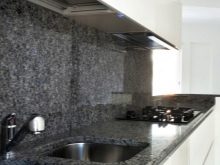
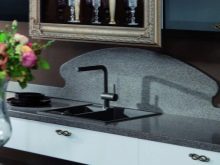
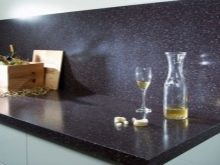
- Agglomerate. This artificial material is very similar to natural, but has a denser, water-repellent structure. It can be considered environmentally friendly, since it consists of 90% natural elements: stone chips, glass, pigments and polyester resin. The material is much lighter than porcelain stoneware and lends itself better to processing.
It is easy to care for it, but it is possible to use the agglomerate as an apron on a shaded wall, where there is no direct sunlight, as it is prone to fading.
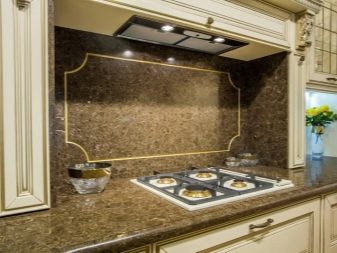
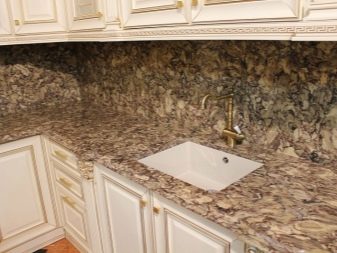
Decorative
Of the many types of decorative materials for creating an apron in the kitchen, the following products are suitable.
- Gypsum. It is easy to make a simulated gypsum stone with your own hands. They can decorate a wall beautifully, but such material is not endowed with water-repellent properties and is poorly suited for use in the kitchen work area.
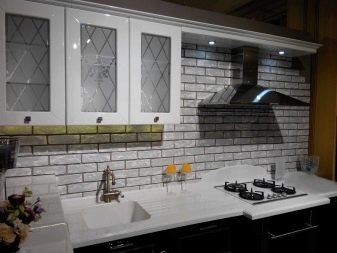

- Pebble mosaic. To create a picture, black and white smooth pebble stones are selected, from which a panel is separately created, which is then installed in the apron area. The product will turn out to be unusual and textured, but it will be difficult to take care of it.
Each tiny stone will have to be cleaned from grease splashes and dirt separately.

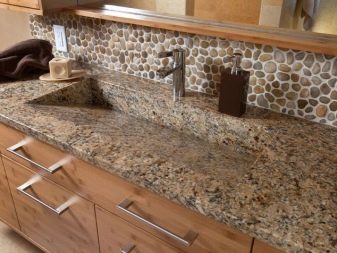
- Brickwork. Well suited for loft and other urban areas. It is sometimes used in country-style kitchens. It is more difficult to care for such a surface than for a smooth monolithic stone.


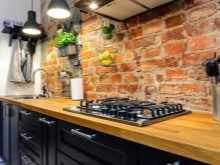
- Porcelain stoneware. A durable man-made material that looks like granite, but structurally has nothing to do with it. The apron over the worktop is difficult to distinguish from expensive natural stone, it looks beautiful and presentable, does not absorb water and dirt, and is easy to clean.
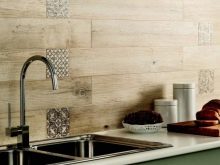
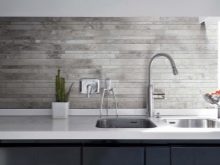
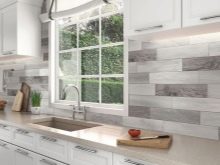
Advantages and disadvantages
A stone apron in the kitchen is a generalizing concept. As already noted, these can be monolithic glossy options, textured porous products, mosaic panels, artificial and natural views. Each product has its own pros and cons.
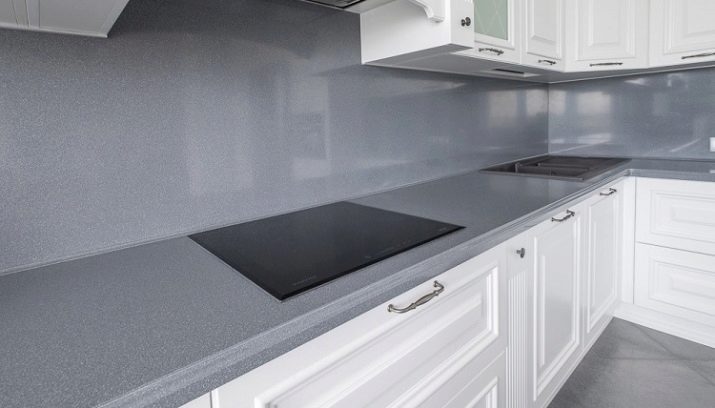
Consider a few general positive criteria.
- Products look spectacular, play with natural notes in the interior.
- Some stylistic areas of the kitchen need the support of natural stone or imitation options.
- An apron made of stone can be chosen for every taste, since this material has numerous types of patterns, colors and textures.
- The stone is strong and durable.
- Artificial surfaces have almost no porosity, moisture and grease are well rejected from them.
- Stone products can be repaired, the damaged part is cleaned, polished and give it its original appearance.
- You can order an apron made of artificial stone, connected to the table top, without a single seam. It is beautiful, hygienic (no dirt collects in the seams) and unusual.
- If the load on the walls from a natural stone is too great, you can always prefer an artificial one, which is lighter in weight, and according to external data is almost indistinguishable from natural.
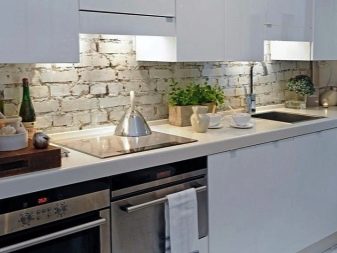
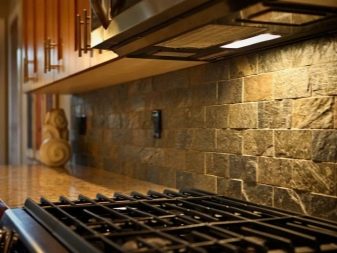
The apron also has disadvantages.
- The high cost of natural stone. Some types of artificial, for example, porcelain stoneware, are also expensive.
- Impossibility of self-assembly.
- The porous structure of natural stone is difficult to maintain.
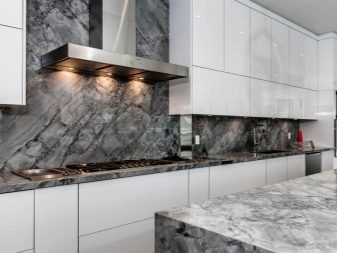
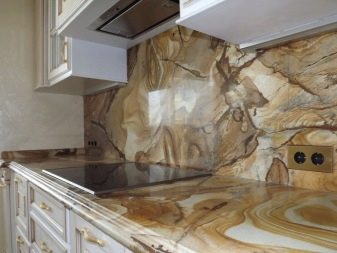
Useful Tips
The stone, especially artificial, is quite in demand for aprons in the kitchen, because it is easy to care for it, and the abundance of species helps to choose the material for different stylistic environments.
Let's take a look at a few tips that take into account the overall design of the room:
- brickwork is ideal for a loft-style interior;
- it is easy to choose material for an apron of the same color for a white kitchen;
- an apron made of artificial stone can be a continuation of the countertop;
- a material with a translucent structure looks good with proper lighting;
- if you need an original kitchen apron, choose a pebble panel;
- for country or gothic styles, rough masonry is suitable.
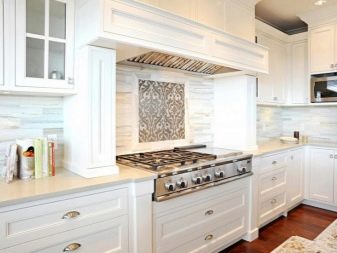

Each kitchen interior requires its own special kind of stone. Rich designs or historical and rustic styles gravitate towards natural material, but many housewives prefer economy and practicality when choosing artificial stone. Anyway, such an apron will become a real decoration of the kitchen.
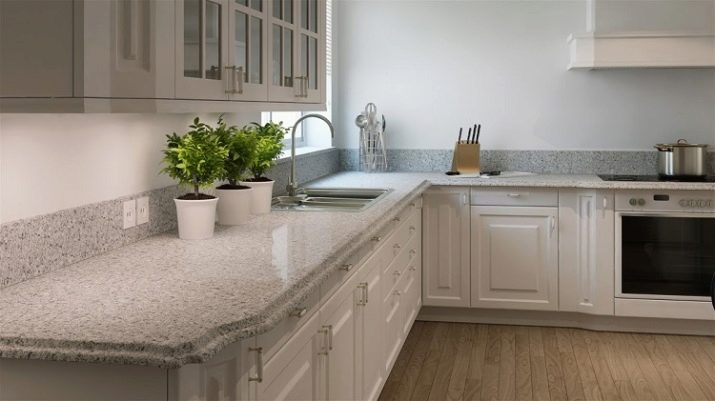
You can find out how to put a stone kitchen apron by watching the video below.








